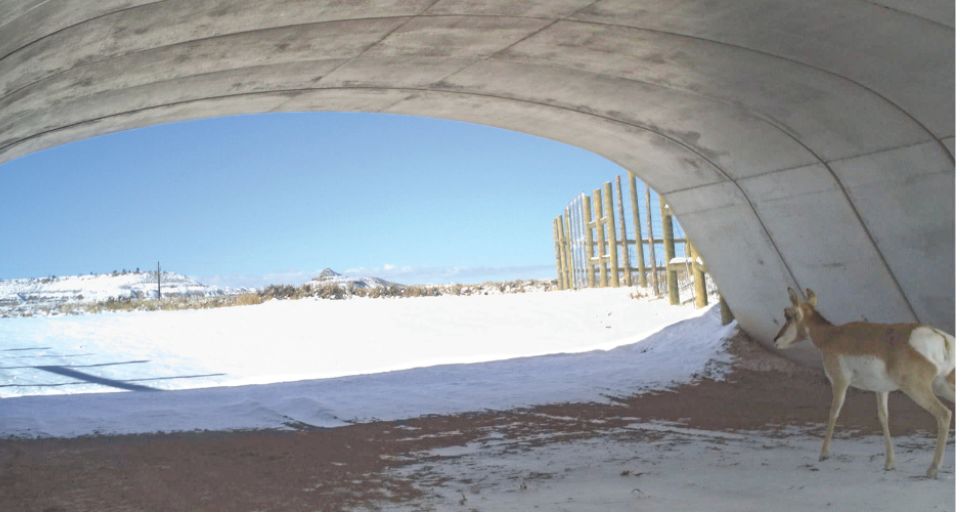One of the current issues in wildlife management is the fragmentation of important habitat. As human populations increase, so do residential development and traffic volumes. Additional development comes with consequences, good and bad. One of the major consequences researchers investigate today is the effect of roads and traffic on wildlife movement and survivability.
In December 2024, the Wyoming Game and Fish Department initiated a GPS collar project along a section of Interstate 80. The Wyoming Department of Transportation and Game and Fish biologists engaged in this research to collect detailed seasonal movements of wildlife and to identify the location for a wildlife overpass structure near Halleck Ridge in Carbon County.
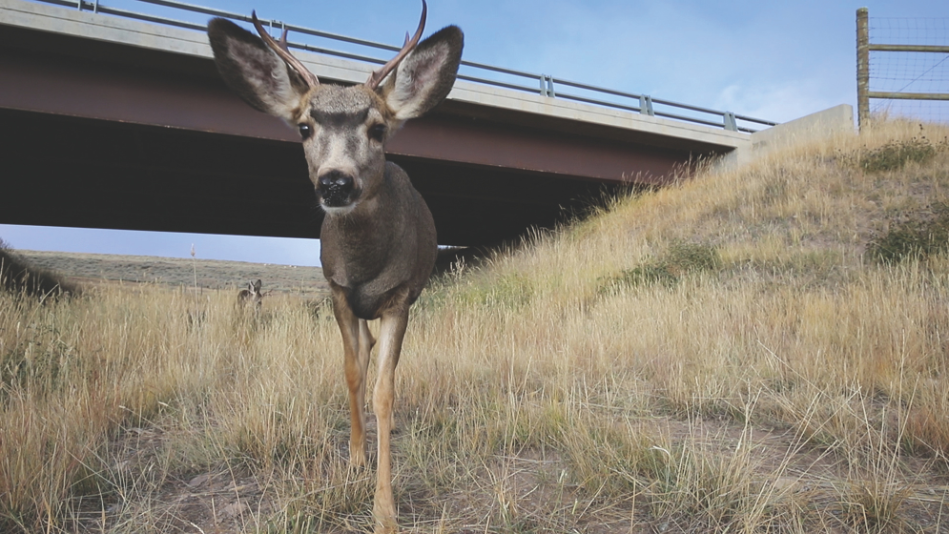
Mule deer and other migrating species utilize underpasses like this one under U.S. Highway 191 west of Pinedale. (Photo by Chris Martin/WGFD)
SAFE CROSSING
Many of us have traveled on I-80 between Laramie and Elk Mountain. Cruising through the grassy landscape we cross over the top of so many machinery underpasses. These features begin to meld into the roadway. If underpasses are so numerous, why is there a proposal for an overpass?
The reasons for this crossing project at Halleck Ridge stemmed from many years of data collection and analysis. In 2017, WYDOT and Game and Fish hosted the Wildlife and Roadways Summit, bringing together state agencies and elected officials, the University of Wyoming, landowners and other stakeholders. Two hundred-forty wildlife crossing opportunities were identified across Wyoming and the Halleck Ridge ranked as the second-highest priority.
“At this time, we began realizing that it's not just one structure that is important, but a system of crossings that can be the biggest help moving forward with a project like this,” said Jake Lonn, WYDOT engineer in Rawlins. “There is a lot of low-hanging fruit with improving existing structures to help wildlife cross the I-80 barrier, along with high fence to funnel them to these locations.”
From this summit, a Reconnaissance Report was completed in 2022 by Western EcoSystems Technology Inc., an environmental consulting agency. The report detailed an analysis of movement data from mule deer and pronghorn and provided enough information that prompted managers to move the project forward. Underpasses, improved fencing and wildlife escape ramps were the first features implemented at Halleck Ridge, which leaves the overpass.
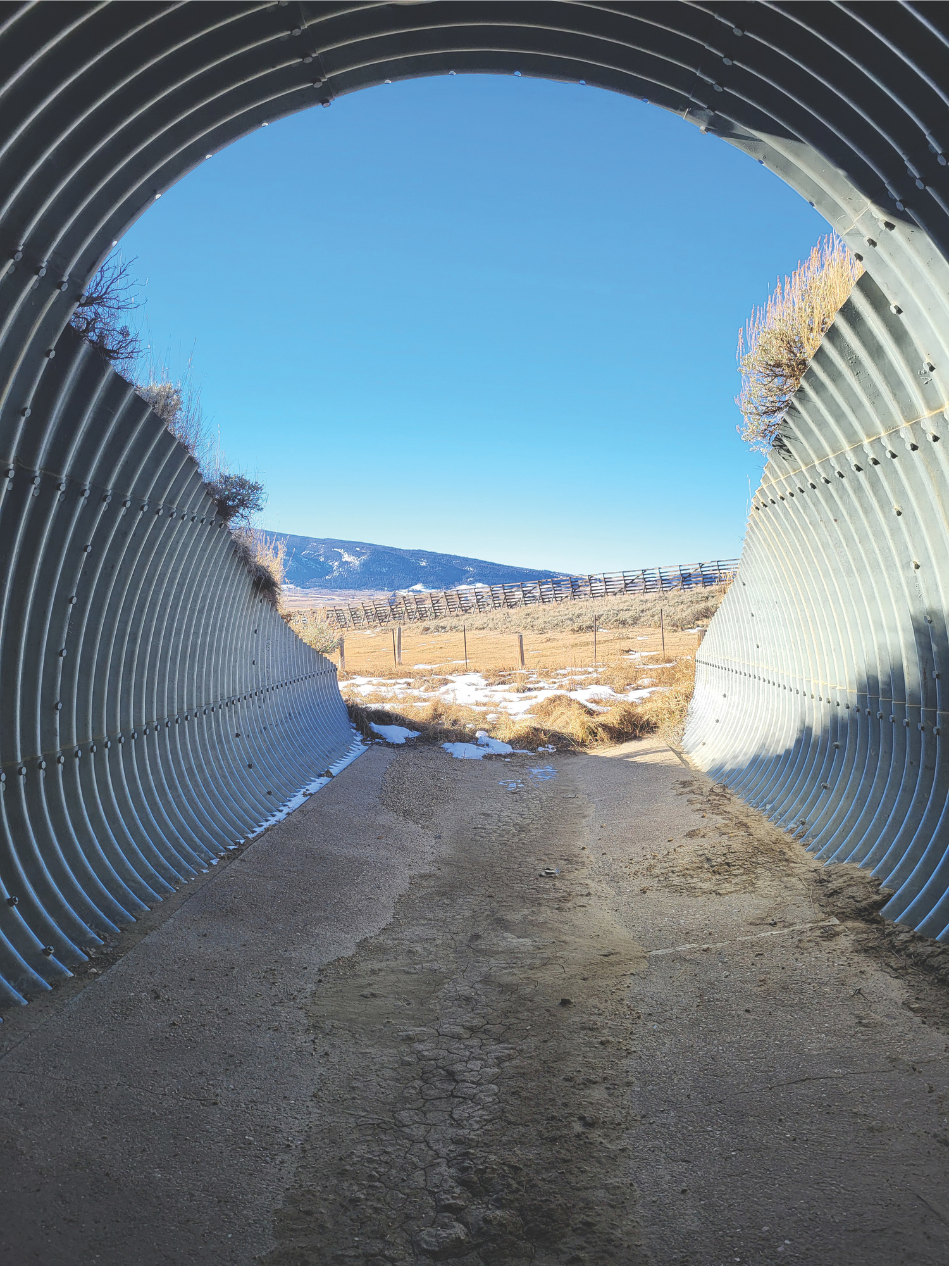
A large underpass with funnel fencing and lots of ambient light and space to move. (Photo by Leah Bell/WGFD)
“When we’re talking millions of dollars to put in a crossing, I think, from a manager standpoint, we want to benefit all the suite of species that we’ve got there,” said Teal Cufaude, Game and Fish wildlife biologist in Saratoga. “And elk, whether we’ve got a lot of them or we don’t, are really important in Wyoming and we need to be thinking of their movement in terms of where to best put these crossings.”
Broadscale reasons for the Halleck Ridge crossing project can be drawn from data across the country comparing two different structures. In a 2023 study analyzing whether wildlife crossing structures reduce the number of wildlife-vehicle collisions, researcher Wisnu Sugiarto found that, “wildlife bridges were more consistently effective in collision reductions than wildlife culverts, though some wildlife culverts had significant effects.” Overpasses boast the advantage of less confining space for animals crossing and have temperature and light exposure making them more conducive to ambient moisture levels. In addition, the width of I-80 would limit a crossing animal’s ability to see to the other side of an underpass, preventing them from utilizing such a structure.
Some anecdotal evidence to support the overpass structure, especially for elk, is first-person observation and camera footage of elk standing on and eventually crossing I-80 during blizzard conditions when the interstate is closed. Elk seem to notice and take advantage of the lack of traffic to migrate across. These big animals also may prefer to cross over the top instead of using the underpasses due to size constraints of underpasses, although this is something we hope to better understand with the new phase of data collection.
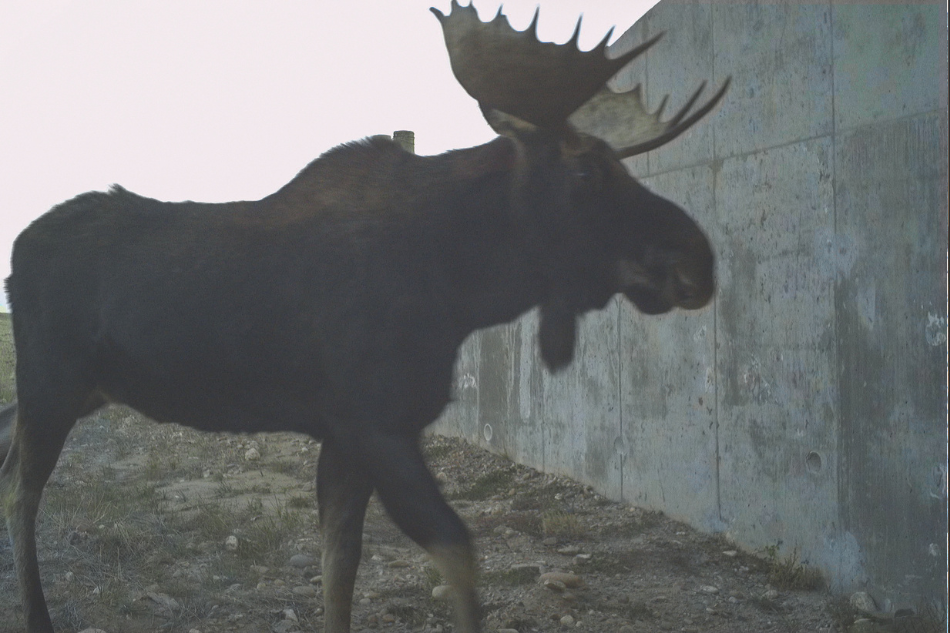
A variety of wildlife can benefit from structures that make it easier for them to cross roadways throughout the state, including this moose between Labarge and Big Piney under U.S. Highway 189. (Photo by Thomas Hart/WYDOT)
A BETTER ROUTE
By giving wildlife another option to cross roads and highways, we are reducing the chances of wildlife-vehicle collisions. In Wyoming between 2016-20, there were an average 7,656 documented big game-vehicle collisions each year, and 87 percent of those were with deer, according to the Wyoming Nature Conservancy. Of those deer, 83 percent were mule deer, and this is a species that has declined in Wyoming. Vehicle collisions are often costly, too, dinging pocketbooks and potentially taking human lives.
In 2021 an elk-vehicle collision cost an average of about $28,000, according to Sugiarto’s report. Of the crashes reported to authorities, an average of 2,923 per year involved significant injury or damage, according to the Wyoming Nature Conservancy. Sugiarto also found that crossing structures can effectively reduce one to three wildlife-vehicle collisions on average per mile every year. Based on these numbers, WYDOT states these collisions cost on average $166,584 per year per mile. With statistics like this, finding a better route for our wild animals to cross I-80 sounds pretty appealing.
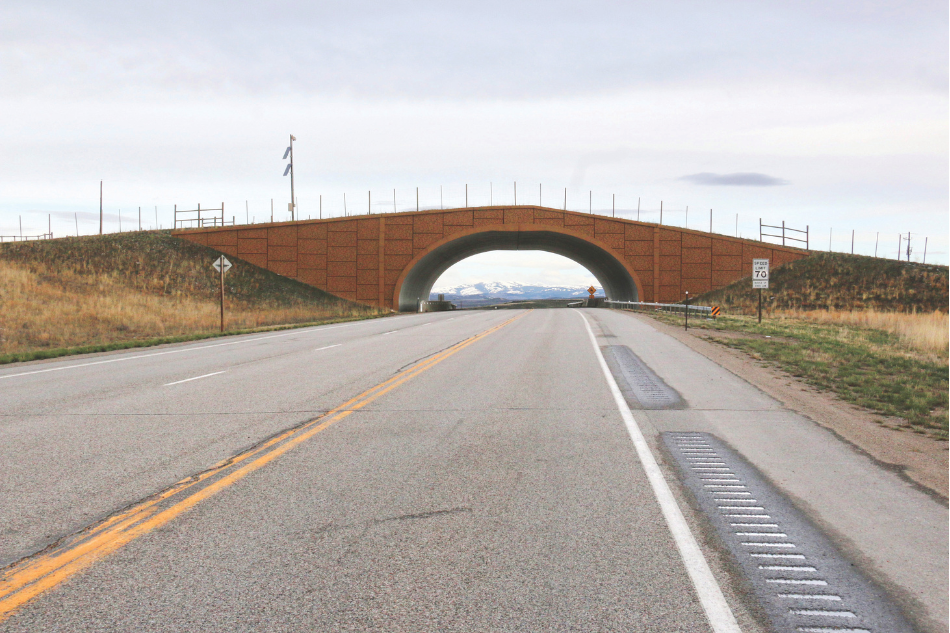
The Trapper's Point overpass west of Pinedale across U.S. Highway 191. The structure was designed for pronghorn and built in 2012.
The effects of roads and highways on animals and humans impact safety and wildlife habitat. Road construction inherently consumes part of the landscape, eliminating wildlife habitat. How this impacts animals depends on the habitat type, the species affected and their needs, and the amount of land consumed. Negative impacts of road and highway construction include habitat loss, habitat quality reduction, fragmenting once contiguous landscapes and the potential threat of invasive species establishment.
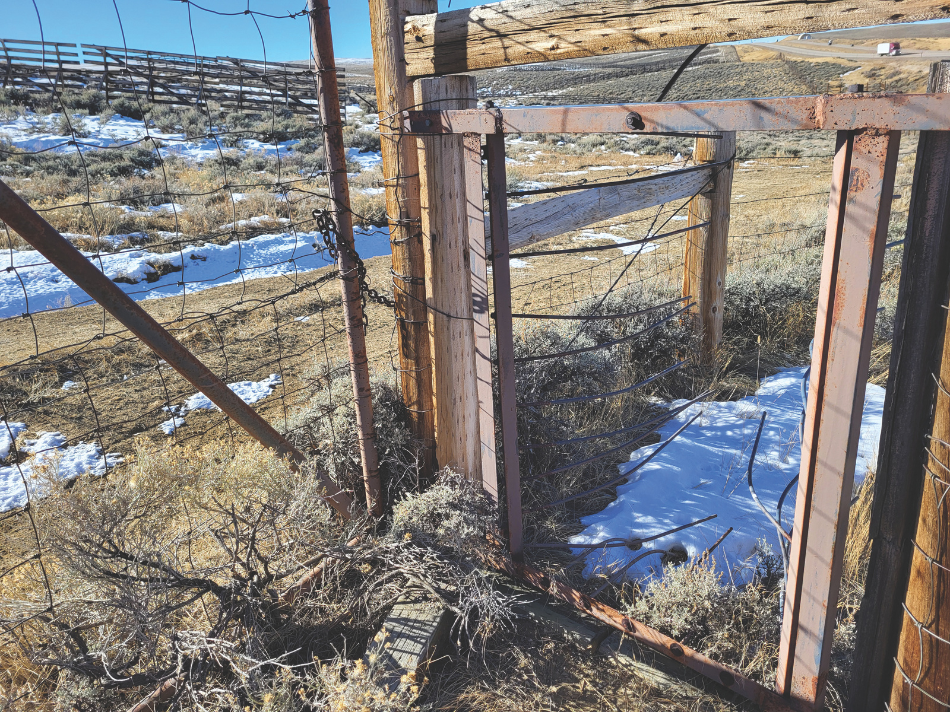
A wildlife-friendly opening in a fence section keeps cattle out, but allows wildlife to pass through to use the underpass. (Photo by Leah Bell/WGFD)
Animals, especially big game like elk, mule deer and pronghorn, generally need large expanses of contiguous land to survive. These ranges change throughout year as ungulates migrate to find more suitable habitat to support them through the winter and again in the spring when forage begins to green up. When roads and highways such as I-80 cut through those paths, animals may have difficulty navigating to their traditional ranges and may be cut off completely if traffic volumes create a barrier. Highway infrastructure may impact big game herds enough that they may choose not to migrate through the impasse, potentially short-stopping their journey on unsuitable habitat for the season.
COLLECTING DATA
Knowing all of these statistics and threats, the research conducted on the current underpasses between Walcott and Elk Mountain will help WYDOT and Game and Fish determine the best location for an overpass and which species may benefit most.
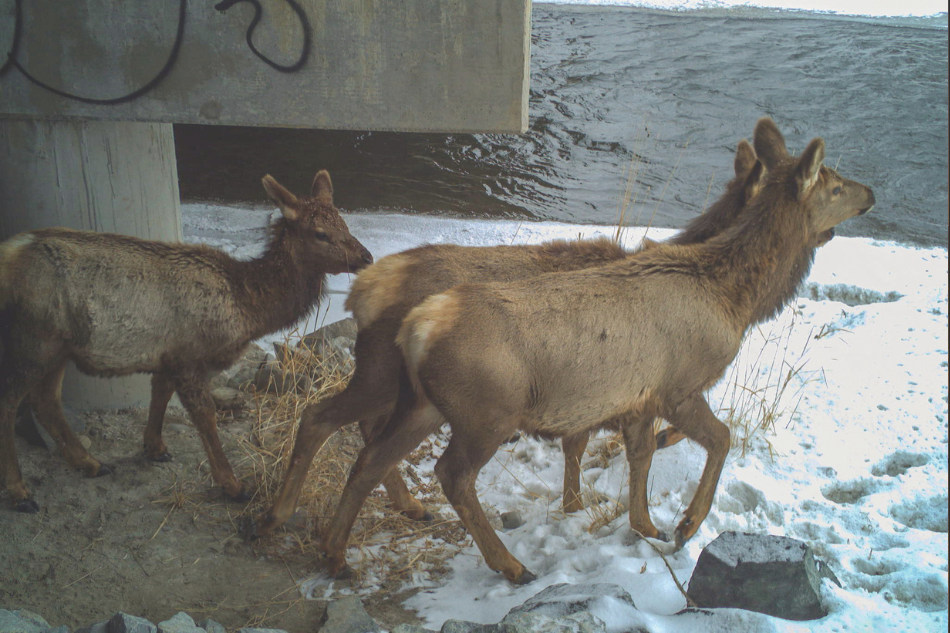
Trail cameras are used by wildlife biologists to expand their observations of wildlife using underpasses and gain insights from other species. This elk image was captured in January 2020 underneath U.S. Highway 89 south of Jackson. (Photo by Thomas Hart/WYDOT)
Some of the key questions we hope to answer from the research data include: At what times are animals crossing the highway? How frequently are elk crossing or attempting to cross?
Does weather impact when or if animals cross?
What underpasses are being most used?
Where are animals trying to cross?
What is the most cost-effective solution?
To better understand how elk interact with I-80, 29 elk were captured and released with radio collars that transmit a GPS location every 16 hours. These fancy necklaces give biologists spatial and temporal data to monitor the condition and movement of these critters. Because GPS data already exists from deer and pronghorn near the study area, elk were the only necessary species to collar.
In addition to radio collar data, trail camera data also will be collected. Trail cameras have been placed at each opening of the underpasses to document what animals travel through and at what frequency. By including camera data, biologists can expand their observations beyond elk and hopefully gain insights from other species traveling along this corridor.
Technicians and biologists will collect data from the GPS collars and trail cameras through August 2028. Biologists will analyze the data to draw conclusions about where to implement the proposed wildlife overpass. A timeline for the completion of this project has yet to be set by WYDOT, and once funded the project is expected to take 3-5 years.
Of course, the construction of an overpass comes at a price, one that goes beyond ecological and intrinsic values. One such ongoing crossing project is on U.S. Highway 189 near Kemmerer. That project, which is on track to go out for bid early this summer, will likely include five underpasses, one overpass and fencing improvements along a 30-mile stretch of highway and is expected to cost $37.4 million once completed.
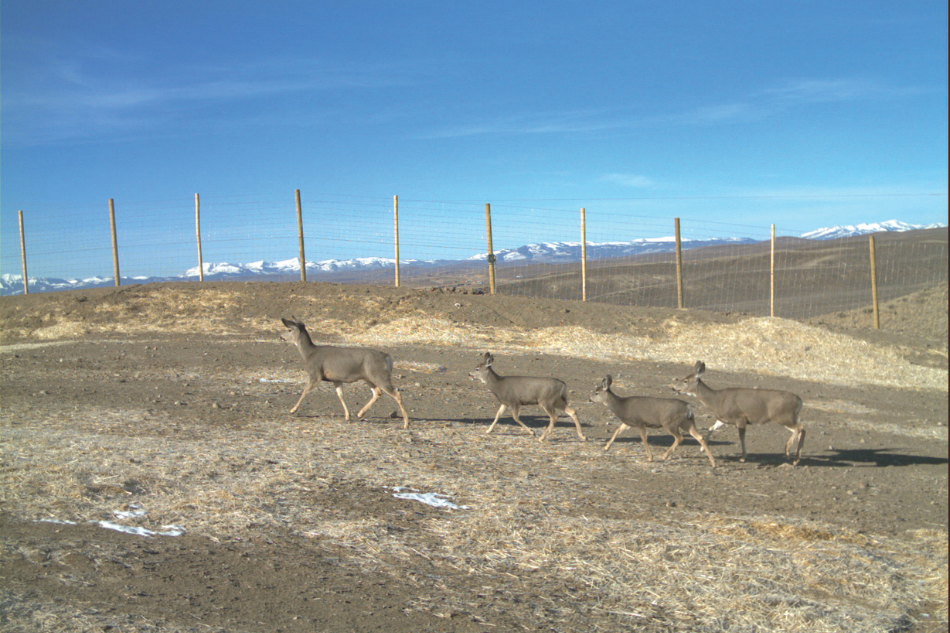
Mule deer cross the Trapper's Point overpass west of Pinedale. Several species utilize this structure including elk, deer and pronghorn.
Funding for all of these projects consists of multiple sources, including grants, taxpayer dollars, potential WYDOT funds, donations, Game and Fish funds and more. A savings calculation on collisions and fatalities from Sugiarto’s research showed that wildlife crossing structures generated annual savings of $235,000-$443,000 in 2021. The sheer amount of wildlife in this state and the statistics of crashes already documented more than warrant the need for wildlife crossing mitigations.
— Leah Bell is a wildlife technician for the Wyoming Game and Fish Department in Laramie. This is her first contribution to Wyoming Wildlife.

